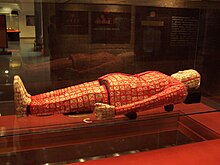Zhao Mo
| Zhao Mo Triệu Văn | |||||||||
|---|---|---|---|---|---|---|---|---|---|
 Zhao Mo's jade sarcophagus with red silk, on display in Guangzhou | |||||||||
| King of Nanyue | |||||||||
| Reign | 137 BC – 122 BC | ||||||||
| Predecessor | Zhao Tuo | ||||||||
| Successor | Zhao Yingqi | ||||||||
| |||||||||
| Dynasty | Nanyue | ||||||||
Zhao Mo (Chinese: 趙眜) was the second ruler of the kingdom of Nanyue (Template:Lang-vi). It included parts of southern China, as well as northern Vietnam. His capital was Panyu, modern Guangzhou. The culture of the kingdom encouraged assimilation between the native Yue and immigrant Chinese. Zhao Mo was a grandson of Zhao Tuo (who had outlived his sons). Compared to his grandfather, Zhao Mo was considered a weak king and allowed Nanyue to fall under the influence of China. (In traditional history, his political weakness is treated as a reflection of personal moral failing.) He rule began in 137 BC and ended with his death in 122 BC. In Chinese history, Nanyue is considered to be a Chinese kingdom. But in Vietnam, he is considered to be a ruler of the Trieu dynasty and a king of Vietnam.
Name
Records from this period were written in classical Chinese and are transliterated, typically into either pinyin (romanized Chinese) or into alphabetical Vietnamese. The given name 趙眜 transliterates as Zhao Mo in pinyin, but as Triệu Mạt in Vietnamese. Zhao/Triệu is a family name, so Zhao Mo's dynasty is referred to as the Triệu Dynasty. His temple name described him as the "literary emperor." (Chinese: 趙文帝; pinyin: Zhào Wén Dì; Template:Lang-vi).

Tomb
The tomb of Wen was discovered in 1983, 20 meters under Elephant Hill in Guangzhou on a construction site for a hotel, and has been excavated. The tomb measures 11 meters long and 12 meters wide. It is divided in seven parts, with a front chamber, east and west wing rooms, the main coffin chamber, east and west side rooms, and a back storage chamber. The tomb has yielded more than 1000 burial artifacts, and a chariot, gold and silver vessels, musical instruments, and human sacrifices were found (15 courtiers were buried alive with him to serve him in death). It is also the only tomb of the early Western Han Dynasty that has murals on its walls.
The tomb also yielded the oldest imperial seal discovered in a Chinese tomb: the seal, with the name "Zhao Mo", declared the royal corpse to be “Emperor Wen", indicating that he considered himself equal in rank to the Han ruler.
Alongside Chinese artifacts, pieces from the steppes, and Iranian and Hellenistic Central Asian regions have been found: a Persian silver box found in the tomb is the earliest imported product found to date in China.
The Museum of the Mausoleum of the Nanyue King, located in Jiefang road in Guangzhou, stands on the site of the tomb of Zhao Mo.
